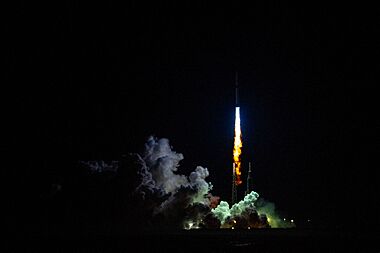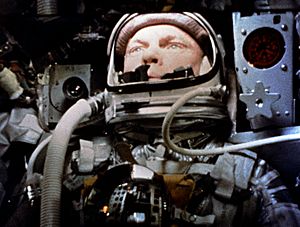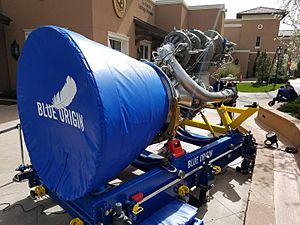New Glenn facts for kids

The inaugural launch of New Glenn, on January 16, 2025
|
|
| Function | Heavy-lift launch vehicle |
|---|---|
| Manufacturer | Blue Origin |
| Country of origin | United States |
| Project cost | At least US$2.5 billion |
| Cost per launch | US$68–110 million |
| Size | |
| Height | 98 m (322 ft) |
| Diameter | 7 m (23 ft) |
| Stages | 2 |
| Capacity | |
| Payload to LEO | 45,000 kg (99,000 lb) |
| Payload to GTO | 13,600 kg (30,000 lb) |
| Payload to TLI | 7,000 kg (15,000 lb) |
| Associated rockets | |
| Comparable |
|
| Launch history | |
| Status | Active |
| Launch sites | Cape Canaveral, LC‑36 Vandenberg, SLC‑9 (future) |
| Total launches | 2 |
| Successes | 2 |
| Landings | 1 / 2 attempts |
| First flight | January 16, 2025 |
| Last flight | November 13, 2025 (most recent) |
| Notable payloads |
|
| First stage – GS1 | |
| Length | 57.5 m (189 ft) |
| Diameter | 7 m (23 ft) |
| Engines | 7 × BE-4 |
| Thrust | 3,850,000 lbf (17,100 kN) |
| Specific impulse | 340 s (3.3 km/s) (vac.) |
| Burn time | 190 seconds |
| Fuel | LOX / CH 4 |
| Second stage – GS2 | |
| Length | 23.4 m (77 ft) |
| Diameter | 7 m (23 ft) |
| Engines | 2 × BE-3U |
| Thrust | 350,000 lbf (1,600 kN) |
| Specific impulse | 445 s (4.36 km/s) |
| Burn time | 644 seconds |
| Fuel | LOX / LH 2 |
The New Glenn is a giant rocket made by an American company called Blue Origin. It is a heavy-lift launch vehicle, meaning it can carry very heavy things into space. It's a two-part rocket, and its first part can be used again. The rocket is 7 meters (about 23 feet) wide.
Seven powerful BE-4 engines push the first part of the rocket. Two BE-3U engines power the second part. Blue Origin designed and built all these engines. New Glenn launches from Cape Canaveral in Florida. Future launches are planned from Vandenberg in California. It is one of three big rockets in the US, like the Vulcan Centaur and Falcon Heavy.
Blue Origin started working on New Glenn before 2013. They officially announced it in 2016. The rocket is named after John Glenn, the first American astronaut to orbit Earth. The first New Glenn rocket was shown in February 2024. Its first flight was on January 16, 2025. It carried a test spacecraft called Blue Ring. This was the first launch from its pad, LC-36, since 2005. It also helped show the rocket was ready for important national security missions.
Like Blue Origin's smaller New Shepard rocket, the New Glenn's first stage can be used again. It lands on a special ship in the ocean called Landing Platform Vessel 1. On November 13, 2025, the first stage landed successfully for the first time! New Glenn will launch the Blue Moon Mark 1 lander to the Moon in early 2026 and late 2027.
Contents
How New Glenn Was Developed
Early Ideas for an Orbital Rocket
Before 2012, Blue Origin started building parts for spacecraft that would carry people into orbit. They designed the first part of the rocket to fly up and then land back down. This is like their New Shepard rocket. This first part would launch the upper part, which would then take astronauts into space. The first part would land upright, ready to be used again.
The idea was to refuel and relaunch the first part. This would make space travel cheaper. This rocket was meant to carry Blue Origin's "Space Vehicle" capsule into orbit. This capsule would take astronauts and supplies. After its mission, the Space Vehicle would come back to Earth. It would land with parachutes and be ready for new flights.
Testing for the rocket's engines began in 2012. They tested the BE-3U engine, which uses liquid oxygen and liquid hydrogen. This test happened at a NASA facility in October 2012. The engine reached its full power. By early 2018, it was decided that the BE-3U engine would power the second part of New Glenn.
Building the Rocket
Designing the New Glenn started in 2012, along with building the BE-4 engines. More plans for this orbital rocket were shared in 2015. For a short time in 2016, people called the rocket "Very Big Brother." It was planned as a two-part rocket using liquid fuel. The rocket was meant to be reusable.
In 2016, Blue Origin hoped to launch the rocket from Florida by 2020. They still aimed for a 2020 launch in September 2017. Blue Origin's president, Rob Meyerson, talked about making progress on the engines and the rocket.
The rocket's design was first shown in September 2016. New Glenn was described as 7 meters wide. It would have two or three parts. The first and second parts would use Blue Origin engines powered by liquid methane and liquid oxygen. The first part was designed to be reusable and land upright. This is like the New Shepard rocket, which has been flying short trips to space since the mid-2010s.
These plans later changed. But in 2016, the first part was to have seven BE-4 engines. The second part would use a special BE-4U engine. A third part, for deep space, would use a BE-3 engine. In 2016, they hoped the first part could fly up to 100 times.
Blue Origin said they would launch the rocket from Launch Complex 36 (LC-36) in Florida. They also planned to build the rockets at a new factory nearby. Testing of the BE-4 engines was also set for Florida. On September 12, 2016, Blue Origin explained the name. New Glenn honors John Glenn, the first American to orbit Earth. The first flight was planned for 2020.
They tested a small model of New Glenn in a wind tunnel for three weeks in September 2016. This helped them check how the rocket would fly at very high speeds. In March 2017, Jeff Bezos showed pictures of New Glenn. It had two large fins at the bottom of its booster. In September 2017, Blue Origin announced a bigger nose cone for New Glenn. It was 7 meters wide, larger than the first plan of 5.4 meters.
By March 2018, the rocket's design changed. The second part of New Glenn would now use two BE-3U engines. A third part, for deep space, would use one BE-3U engine. But the plan for a three-part rocket was canceled in January 2019. By mid-2018, the detailed design was still not finished. Many people wondered if the rocket would really launch by 2020.
In October 2018, the Air Force gave Blue Origin $500 million. This was to help develop New Glenn for future space missions. However, this funding was stopped in December 2020. Blue Origin had received $255.5 million by then.
By February 2019, New Glenn had several launch contracts. These included five launches for OneWeb and others for Telesat, Eutelsat, mu Space Corp, and SKY Perfect JSAT. In February 2019, Blue Origin said they had no plans for a reusable second stage. But by July 2021, they were looking into it again with "Project Jarvis."
In August 2020, the Air Force did not choose New Glenn for a big national security launch program. Because of this, Blue Origin said in February 2021 that the first flight would be delayed until late 2022. By December 2020, Blue Origin's BE-4 engines were delayed until summer 2021. This also delayed the launch of a rival rocket, the ULA Vulcan Centaur.
In March 2021, Blue Origin announced another delay. New Glenn would not launch until late 2022 at the earliest. By 2021, Blue Origin changed its goal for reusing the first stage. They aimed for at least 25 flights, down from the earlier goal of 100 flights. In March 2022, the first launch of New Glenn was delayed again, to late 2023.
In January 2024, the first part of New Glenn was moved to the launchpad. This was to get ready for a launch later that year. In February 2024, a test version of New Glenn's first and second parts stood on the launchpad. It wasn't ready to fly, as it had no engines. In May 2024, New Glenn was moved out again for more tests before a planned launch.
"Jarvis" Reusable Upper Stage Project

In July 2021, news came out about "Project Jarvis." Blue Origin started this project to make the second part of New Glenn fully reusable. SpaceX has a similar goal for its Starship rocket. If Project Jarvis works, New Glenn would be fully reusable. This would make each launch much cheaper.
Jeff Bezos also changed how the project was managed. He wanted the team to be free to try new ideas without too much paperwork. The public did not learn about the budget for this reusable second stage.
Part of the project focused on building a stainless steel fuel tank and main structure for the second stage. They tested this tank with very cold fuels. In August 2021, Blue Origin moved a stainless steel test tank to their launch site. They planned to test its pressure with cryogenic propellants.
Another team at Blue Origin also worked on making the second stage reusable. They explored three ideas. One was adding wings to the stage so it could fly back like a spaceplane. Another was using a special engine that could also act as a heat shield. The third idea was like SpaceX's Starship, using big flaps and rocket power to slow down. A decision on which idea to use was expected in late 2021. In September 2024, Jeff Bezos said Project Jarvis was looking at aluminum or stainless steel for heat protection. He also said if the non-reusable second stage was cheaper, Project Jarvis would end. After the first successful flight in January 2025, reports said Project Jarvis was put on hold.
First Launch of New Glenn
On June 12, 2024, Blue Origin received the license for New Glenn's first flight. The rocket was chosen for the U.S. NSSL program. The first launch was expected by December 2024.
Preparations began in late August for the first launch. It was to carry the ESCAPADE mission, with two satellites going to Mars for NASA. After talking with NASA, they decided to skip the October launch time. This avoided extra costs and risks.
By September 2024, the first launch was planned as a test for the United States Space Force. It carried a prototype Blue Ring spacecraft. The booster for this flight was named So You're Telling Me There's a Chance. This name hinted at how hard it is to land a reusable booster on the first try.
Testing continued in October 2024 with successful hot fire tests of the second stage. The completed first stage (GS1) moved to the launchpad on October 30, 2024. This was in preparation for the first flight.
The Flight 1 vehicle moved to the launchpad on November 20, 2024, for static fire testing. A full practice run with fuel happened on December 19, 2024. A 24-second static fire test was done on December 27.
On January 13, 2025, Blue Origin tried their first launch. After some delays, the launch was called off around 3:05 AM EST.
On January 16, 2025, at 2:03 AM EST, New Glenn launched for the first time. Blue Origin reached orbit on its first try. The second stage and Blue Ring prototype went into medium Earth orbit. Blue Origin stated that GS-1, the first stage, was lost during its return. Data showed the booster was traveling very fast at a high altitude before it was lost.
After the landing did not work, Blue Origin led an investigation. The FAA also reviewed it. This investigation into the booster's return was finished by March 31, 2025.
New Glenn's Design and Features

New Glenn is a 7-meter (about 23-foot) wide rocket with two main parts. The first part can be used again. The second part is used once and then discarded. An optional third stage was considered, but it was later removed from the plans.
The first stage (GS1) is designed to be used at least 25 times. It lands vertically, a technology Blue Origin first tested on its New Shepard rocket in 2015–2016. The second stage (GS2) is about 26.8 meters (88 feet) tall. Both stages use strong aluminum tanks.
The first stage has seven BE-4 methane/oxygen engines. These engines, made by Blue Origin, produce a huge amount of thrust at liftoff. Its liquid oxygen tank holds about 30,000 cubic feet of fuel. The methane fuel tank holds almost 25,000 cubic feet. The second stage uses two BE-3U engines, also made by Blue Origin. These engines use hydrogen and oxygen as fuel.
In 2019, the company said the two-stage New Glenn could carry 13,000 kg (about 28,660 pounds) to GTO. It could also carry 45,000 kg (about 99,200 pounds) to a LEO. After the first five flights, they planned to offer launches for two satellites at once.
New Glenn launches from Cape Canaveral Space Force Station in Florida. Blue Origin leased Launch Complex 36 (LC-36) in 2015 for this rocket. Blue Origin and the U.S. Space Force plan to build a launch site in California. This site, Space Launch Complex 9 (SLC-9), will allow New Glenn to reach polar orbits.
New Glenn will also offer space tourism flights. Customers of New Shepard will get priority. The first stage boosters are meant to be reusable. They were originally planned to land on a special ship called Jacklyn in the Atlantic Ocean. This ship was designed to handle rough seas. That ship was later scrapped. A new landing barge, also nicknamed Jacklyn, became ready in 2024.
Where New Glenn is Built
The main assembly of the New Glenn rocket happens at the Blue Origin rocket manufacturing facility in Florida. This factory is near Launch Complex 36 (LC-36). Blue Origin leased LC-36 from Spaceport Florida. LC-36 has hosted over 100 launches in the past.
Tools and equipment for the factory were ordered starting in 2015. In July 2018, the biggest machine was finished. It was a huge "Mongoose" machine from Ingersoll. It builds cryogenic fuel tanks and nose cones. It was installed in the Florida factory later in 2018. By September 2018, Blue Origin had invested over $1 billion in its Florida factory and launch site. They planned to spend much more.
Launch Services for Customers
As of 2018, Blue Origin planned to offer flights for single payloads. After the fifth launch, they also planned to carry two large communication satellites to geostationary transfer orbit (GTO). All contracted launches will use a reusable first stage. This means landing conditions can affect the launch time. After the first launch in January 2025, which put its payload into orbit but lost the booster, future launches are on hold. Blue Origin and the FAA are investigating why the booster did not return successfully.
Who Are New Glenn's Customers?
By 2018, Blue Origin had contracts with four customers for New Glenn flights. Eutelsat, mu Space Corp, and SKY Perfect JSAT planned to launch communication satellites after 2020. OneWeb, which operates a fleet of internet satellites, had an agreement for five launches by 2018.
In January 2019, Telesat signed a contract for multiple launches. New Glenn will launch satellites for Telesat's future internet network in low-Earth orbit. This made Telesat Blue Origin's fifth customer.
In 2022, Amazon announced a contract for 12 New Glenn flights. They also had an option for 15 more. These flights will deploy Amazon's Kuiper satellite constellation.
In February 2023, NASA chose Blue Origin to launch the ESCAPADE spacecraft to Mars. In May 2024, the spacecraft was almost ready for launch. However, NASA later moved the ESCAPADE payload to a different New Glenn flight.
In November 2024, AST SpaceMobile chose Blue Origin to launch some of its Block 2 satellites.
Launch Schedule Approach
Blue Origin plans to offer launch services differently from how it's usually done. The company aims for a regular launch schedule, up to eight launches a year. If one customer's payload for a multi-payload launch isn't ready, Blue Origin will still launch on time. They will fly the remaining payloads without extra cost. This is different from how other companies handle dual-launch contracts.
Funding for New Glenn
Jeff Bezos, the founder of Amazon.com, and the Department of the Air Force are funding the development and building of New Glenn. Initially, Bezos funded it entirely. After 2019, New Glenn also received $500 million from the United States Space Force National Security Space Launch (NSSL) program. By September 2017, Bezos had invested $2.5 billion into New Glenn.
See also
 In Spanish: New Glenn para niños
In Spanish: New Glenn para niños
- List of New Glenn launches
- Space launch market competition
- Falcon Heavy (SpaceX)
- Ariane 6 (Arianespace)
- Vulcan Centaur (United Launch Alliance)
- SpaceX Starship
- Space Launch System (NASA/Boeing), not for commercial satellites
- Comparison of orbital launch systems
- Comparison of orbital launchers families
- Blue Origin recovery vessel



